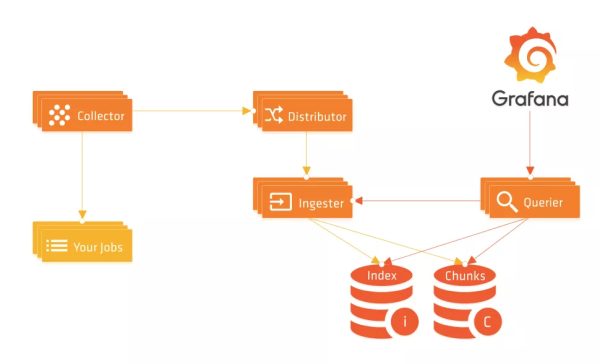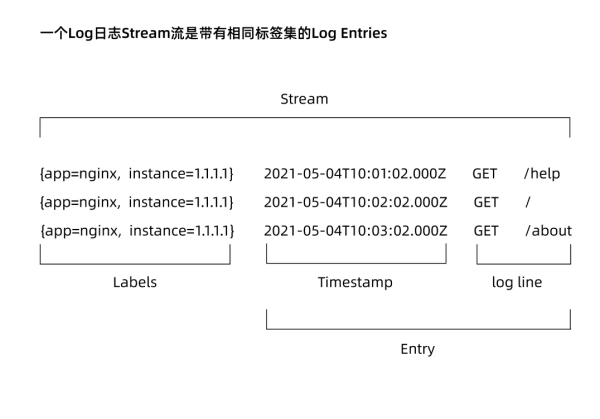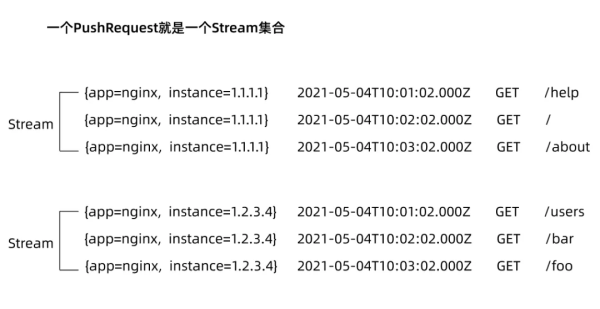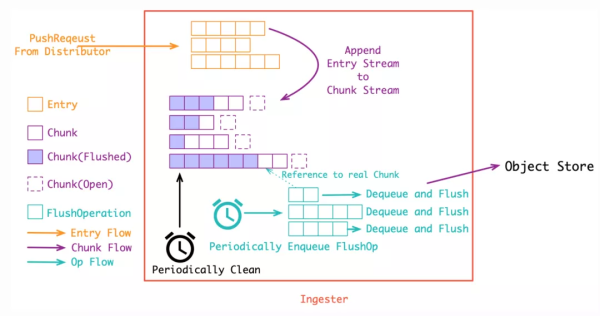您好,登錄后才能下訂單哦!
您好,登錄后才能下訂單哦!
本篇內容介紹了“Loki 的作用是什么”的有關知識,在實際案例的操作過程中,不少人都會遇到這樣的困境,接下來就讓小編帶領大家學習一下如何處理這些情況吧!希望大家仔細閱讀,能夠學有所成!
前面我們介紹了 Loki 的一些基本使用配置,但是對 Loki 還是了解不夠深入,官方文檔寫得較為凌亂,而且沒有跟上新版本,為了能夠對 Loki 有一個更深入的認識,做到有的放矢,這里面我們嘗試對 Loki 的源碼進行一些簡單的分析,由于有很多模塊和實現細節,這里我們主要是對核心功能進行分析,希望對大家有所幫助。本文首先對日志的寫入過程進行簡單分析。

Promtail 通過 Loki 的 Push API 接口推送日志數據,該接口在初始化 Distributor 的時候進行初始化,在控制器基礎上包裝了兩個中間件,其中的 HTTPAuthMiddleware 就是獲取租戶 ID,如果開啟了認證配置,則從 X-Scope-OrgID 這個請求 Header 頭里面獲取,如果沒有配置則用默認的 fake 代替。
// pkg/loki/modules.go func (t *Loki) initDistributor() (services.Service, error) { ...... if t.cfg.Target != All { logproto.RegisterPusherServer(t.Server.GRPC, t.distributor) } pushHandler := middleware.Merge( serverutil.RecoveryHTTPMiddleware, t.HTTPAuthMiddleware, ).Wrap(http.HandlerFunc(t.distributor.PushHandler)) t.Server.HTTP.Handle("/api/prom/push", pushHandler) t.Server.HTTP.Handle("/loki/api/v1/push", pushHandler) return t.distributor, nil }Push API 處理器實現如下所示,首先通過 ParseRequest 函數將 Http 請求轉換成 logproto.PushRequest,然后直接調用 Distributor 下面的 Push 函數來推送日志數據:
// pkg/distributor/http.go // PushHandler 從 HTTP body 中讀取一個 snappy 壓縮的 proto func (d *Distributor) PushHandler(w http.ResponseWriter, r *http.Request) { logger := util_log.WithContext(r.Context(), util_log.Logger) userID, _ := user.ExtractOrgID(r.Context()) req, err := ParseRequest(logger, userID, r) ...... _, err = d.Push(r.Context(), req) ...... } func ParseRequest(logger gokit.Logger, userID string, r *http.Request) (*logproto.PushRequest, error) { var body lokiutil.SizeReader contentEncoding := r.Header.Get(contentEnc) switch contentEncoding { case "": body = lokiutil.NewSizeReader(r.Body) case "snappy": body = lokiutil.NewSizeReader(r.Body) case "gzip": gzipReader, err := gzip.NewReader(r.Body) if err != nil { return nil, err } defer gzipReader.Close() body = lokiutil.NewSizeReader(gzipReader) default: return nil, fmt.Errorf("Content-Encoding %q not supported", contentEncoding) } contentType := r.Header.Get(contentType) var req logproto.PushRequest ...... switch contentType { case applicationJSON: var err error if loghttp.GetVersion(r.RequestURI) == loghttp.VersionV1 { err = unmarshal.DecodePushRequest(body, &req) } else { err = unmarshal_legacy.DecodePushRequest(body, &req) } if err != nil { return nil, err } default: // When no content-type header is set or when it is set to // `application/x-protobuf`: expect snappy compression. if err := util.ParseProtoReader(r.Context(), body, int(r.ContentLength), math.MaxInt32, &req, util.RawSnappy); err != nil { return nil, err } } return &req, nil }首先我們先了解下 PushRequest 的結構,PushRequest 就是一個 Stream 集合:
// pkg/logproto/logproto.pb.go type PushRequest struct { Streams []Stream `protobuf:"bytes,1,rep,name=streams,proto3,customtype=Stream" json:"streams"` } // pkg/logproto/types.go // Stream 流包含一個唯一的標簽集,作為一個字符串,然后還包含一組日志條目 type Stream struct { Labels string `protobuf:"bytes,1,opt,name=labels,proto3" json:"labels"` Entries []Entry `protobuf:"bytes,2,rep,name=entries,proto3,customtype=EntryAdapter" json:"entries"` } // Entry 是一個帶有時間戳的日志條目 type Entry struct { Timestamp time.Time `protobuf:"bytes,1,opt,name=timestamp,proto3,stdtime" json:"ts"` Line string `protobuf:"bytes,2,opt,name=line,proto3" json:"line"` } 

然后查看 Distributor 下的 Push 函數實現:
// pkg/distributor/distributor.go // Push 日志流集合 func (d *Distributor) Push(ctx context.Context, req *logproto.PushRequest) (*logproto.PushResponse, error) { // 獲取租戶ID userID, err := user.ExtractOrgID(ctx) ...... // 首先把請求平鋪成一個樣本的列表 streams := make([]streamTracker, 0, len(req.Streams)) keys := make([]uint32, 0, len(req.Streams)) var validationErr error validatedSamplesSize := 0 validatedSamplesCount := 0 validationContext := d.validator.getValidationContextFor(userID) for _, stream := range req.Streams { // 解析日志流標簽 stream.Labels, err = d.parseStreamLabels(validationContext, stream.Labels, &stream) ...... n := 0 for _, entry := range stream.Entries { // 校驗一個日志Entry實體 if err := d.validator.ValidateEntry(validationContext, stream.Labels, entry); err != nil { validationErr = err continue } stream.Entries[n] = entry n++ // 校驗成功的樣本大小和個數 validatedSamplesSize += len(entry.Line) validatedSamplesCount++ } // 去掉校驗失敗的實體 stream.Entries = stream.Entries[:n] if len(stream.Entries) == 0 { continue } // 為當前日志流生成用于hash換的token值 keys = append(keys, util.TokenFor(userID, stream.Labels)) streams = append(streams, streamTracker{ stream: stream, }) } if len(streams) == 0 { return &logproto.PushResponse{}, validationErr } now := time.Now() // 每個租戶有一個限速器,判斷可以正常傳輸的日志大小是否應該被限制 if !d.ingestionRateLimiter.AllowN(now, userID, validatedSamplesSize) { // 返回429表明客戶端被限速了 ...... return nil, httpgrpc.Errorf(http.StatusTooManyRequests, validation.RateLimitedErrorMsg, int(d.ingestionRateLimiter.Limit(now, userID)), validatedSamplesCount, validatedSamplesSize) } const maxExpectedReplicationSet = 5 // typical replication factor 3 plus one for inactive plus one for luck var descs [maxExpectedReplicationSet]ring.InstanceDesc samplesByIngester := map[string][]*streamTracker{} ingesterDescs := map[string]ring.InstanceDesc{} for i, key := range keys { // ReplicationSet 描述了一個指定的鍵與哪些 Ingesters 進行對話,以及可以容忍多少個錯誤 // 根據 label hash 到 hash 環上獲取對應的 ingester 節點,一個節點可能有多個對等的 ingester 副本來做 HA replicationSet, err := d.ingestersRing.Get(key, ring.Write, descs[:0], nil, nil) ...... // 最小成功的實例樹 streams[i].minSuccess = len(replicationSet.Ingesters) - replicationSet.MaxErrors // 可容忍的最大故障實例數 streams[i].maxFailures = replicationSet.MaxErrors // 將 Stream 按對應的 ingester 進行分組 for _, ingester := range replicationSet.Ingesters { // 配置每個 ingester 副本對應的日志流數據 samplesByIngester[ingester.Addr] = append(samplesByIngester[ingester.Addr], &streams[i]) ingesterDescs[ingester.Addr] = ingester } } tracker := pushTracker{ done: make(chan struct{}), err: make(chan error), } tracker.samplesPending.Store(int32(len(streams))) // 循環Ingesters for ingester, samples := range samplesByIngester { // 讓ingester并行處理通過hash環對應的日志流列表 go func(ingester ring.InstanceDesc, samples []*streamTracker) { ...... // 將日志流樣本數據下發給對應的 ingester 節點 d.sendSamples(localCtx, ingester, samples, &tracker) }(ingesterDescs[ingester], samples) } ...... }Push 函數的核心就是根據日志流的標簽來計算一個 Token 值,根據這個 Token 值去哈希環上獲取對應的處理日志的 Ingester 實例,然后并行通過 Ingester 處理日志流數據,通過 sendSamples 函數為單個 ingester 去發送日志樣本數據:
// pkg/distributor/distributor.go func (d *Distributor) sendSamples(ctx context.Context, ingester ring.InstanceDesc, streamTrackers []*streamTracker, pushTracker *pushTracker) { err := d.sendSamplesErr(ctx, ingester, streamTrackers) ...... } func (d *Distributor) sendSamplesErr(ctx context.Context, ingester ring.InstanceDesc, streams []*streamTracker) error { // 根據 ingester 地址獲取 client c, err := d.pool.GetClientFor(ingester.Addr) ...... // 重新構造 PushRequest req := &logproto.PushRequest{ Streams: make([]logproto.Stream, len(streams)), } for i, s := range streams { req.Streams[i] = s.stream } // 通過 Ingester 客戶端請求數據 _, err = c.(logproto.PusherClient).Push(ctx, req) ...... }Ingester 客戶端中的 Push 函數實際上就是一個 gRPC 服務的客戶端:
// pkg/ingester/ingester.go // Push 實現 logproto.Pusher. func (i *Ingester) Push(ctx context.Context, req *logproto.PushRequest) (*logproto.PushResponse, error) { // 獲取租戶ID instanceID, err := user.ExtractOrgID(ctx) ...... // 根據租戶ID獲取 instance 對象 instance := i.getOrCreateInstance(instanceID) // 直接調用 instance 對象 Push 數據 err = instance.Push(ctx, req) return &logproto.PushResponse{}, err }instance 下的 Push 函數:
// pkg/ingester/instance.go func (i *instance) Push(ctx context.Context, req *logproto.PushRequest) error { record := recordPool.GetRecord() record.UserID = i.instanceID defer recordPool.PutRecord(record) i.streamsMtx.Lock() defer i.streamsMtx.Unlock() var appendErr error for _, s := range req.Streams { // 獲取一個 stream 對象 stream, err := i.getOrCreateStream(s, false, record) if err != nil { appendErr = err continue } // 真正用于數據處理的是 stream 對象中的 Push 函數 if _, err := stream.Push(ctx, s.Entries, record); err != nil { appendErr = err continue } } ...... return appendErr } func (i *instance) getOrCreateStream(pushReqStream logproto.Stream, lock bool, record *WALRecord) (*stream, error) { if lock { i.streamsMtx.Lock() defer i.streamsMtx.Unlock() } // 如果 streams 中包含當前標簽列表對應的 stream 對象,則直接返回 stream, ok := i.streams[pushReqStream.Labels] if ok { return stream, nil } // record 只在重放 WAL 時為 nil // 我們不希望在重放 WAL 后丟掉數據 // 為 instance 降低 stream 流限制 var err error if record != nil { // 限流器判斷 // AssertMaxStreamsPerUser 確保與當前輸入的流數量沒有達到限制 err = i.limiter.AssertMaxStreamsPerUser(i.instanceID, len(i.streams)) } ...... // 解析日志流標簽集 labels, err := logql.ParseLabels(pushReqStream.Labels) ...... // 獲取對應標簽集的指紋 fp := i.getHashForLabels(labels) // 重新實例化一個 stream 對象,這里還會維護日志流的倒排索引 sortedLabels := i.index.Add(client.FromLabelsToLabelAdapters(labels), fp) stream = newStream(i.cfg, fp, sortedLabels, i.metrics) // 將stream設置到streams中去 i.streams[pushReqStream.Labels] = stream i.streamsByFP[fp] = stream // 當重放 wal 的時候 record 是 nil (我們不希望在重放時重寫 wal entries). if record != nil { record.Series = append(record.Series, tsdb_record.RefSeries{ Ref: uint64(fp), Labels: sortedLabels, }) } else { // 如果 record 為 nil,這就是一個 WAL 恢復 i.metrics.recoveredStreamsTotal.Inc() } ...... i.addTailersToNewStream(stream) return stream, nil }這個里面涉及到 WAL 這一塊的設計,比較復雜,我們可以先看 stream 下面的 Push 函數實現,主要就是將收到的 []Entry 先 Append 到內存中的 Chunk 流([]chunkDesc) 中:
// pkg/ingester/stream.go func (s *stream) Push(ctx context.Context, entries []logproto.Entry, record *WALRecord) (int, error) { s.chunkMtx.Lock() defer s.chunkMtx.Unlock() var bytesAdded int prevNumChunks := len(s.chunks) var lastChunkTimestamp time.Time // 如果之前的 chunks 列表為空,則創建一個新的 chunk if prevNumChunks == 0 { s.chunks = append(s.chunks, chunkDesc{ chunk: s.NewChunk(), }) chunksCreatedTotal.Inc() } else { // 獲取最新一個chunk的日志時間戳 _, lastChunkTimestamp = s.chunks[len(s.chunks)-1].chunk.Bounds() } var storedEntries []logproto.Entry failedEntriesWithError := []entryWithError{} for i := range entries { // 如果這個日志條目與我們最后 append 的一行的時間戳和內容相匹配,則忽略它 if entries[i].Timestamp.Equal(s.lastLine.ts) && entries[i].Line == s.lastLine.content { continue } // 最新的一個 chunk chunk := &s.chunks[len(s.chunks)-1] // 如果當前chunk已經關閉 或者 已經達到設置的最大 Chunk 大小 if chunk.closed || !chunk.chunk.SpaceFor(&entries[i]) || s.cutChunkForSynchronization(entries[i].Timestamp, lastChunkTimestamp, chunk, s.cfg.SyncPeriod, s.cfg.SyncMinUtilization) { // 如果 chunk 沒有更多的空間,則調用 Close 來以確保 head block 中的數據都被切割和壓縮。 err := chunk.chunk.Close() ...... chunk.closed = true ...... // Append 一個新的 Chunk s.chunks = append(s.chunks, chunkDesc{ chunk: s.NewChunk(), }) chunk = &s.chunks[len(s.chunks)-1] lastChunkTimestamp = time.Time{} } // 往 chunk 里面 Append 日志數據 if err := chunk.chunk.Append(&entries[i]); err != nil { failedEntriesWithError = append(failedEntriesWithError, entryWithError{&entries[i], err}) } else { // 存儲添加到 chunk 中的日志數據 storedEntries = append(storedEntries, entries[i]) // 配置最后日志行的數據 lastChunkTimestamp = entries[i].Timestamp s.lastLine.ts = lastChunkTimestamp s.lastLine.content = entries[i].Line // 累計大小 bytesAdded += len(entries[i].Line) } chunk.lastUpdated = time.Now() } if len(storedEntries) != 0 { // 當重放 wal 的時候 record 將為 nil(我們不希望在重放的時候重寫wal日志條目) if record != nil { record.AddEntries(uint64(s.fp), storedEntries...) } // 后續是用與tail日志的處理 ...... } ...... // 如果新增了chunks if len(s.chunks) != prevNumChunks { memoryChunks.Add(float64(len(s.chunks) - prevNumChunks)) } return bytesAdded, nil }Chunk 其實就是多條日志構成的壓縮包,將日志壓成 Chunk 的可以直接存入對象存儲, 一個 Chunk 到達指定大小之前會不斷 Append 新的日志到里面,而在達到大小之后, Chunk 就會關閉等待持久化(強制持久化也會關閉 Chunk, 比如關閉 ingester 實例時就會關閉所有的 Chunk 并持久化)。Chunk 的大小控制很重要:
假如 Chunk 容量過小: 首先是導致壓縮效率不高,同時也會增加整體的 Chunk 數量, 導致倒排索引過大,最后, 對象存儲的操作次數也會變多, 帶來額外的性能開銷
假如 Chunk 過大: 一個 Chunk 的 open 時間會更長, 占用額外的內存空間, 同時, 也增加了丟數據的風險,Chunk 過大也會導致查詢讀放大

在將日志流追加到 Chunk 中過后,在 Ingester 初始化時會啟動兩個循環去處理 Chunk 數據,分別從 chunks 數據取出存入優先級隊列,另外一個循環定期檢查從內存中刪除已經持久化過后的數據。
首先是 Ingester 中定義了一個 flushQueues 屬性,是一個優先級隊列數組,該隊列中存放的是 flushOp:
// pkg/ingester/ingester.go type Ingester struct { services.Service ...... // 每個 flush 線程一個隊列,指紋用來選擇隊列 flushQueues []*util.PriorityQueue // 優先級隊列數組 flushQueuesDone sync.WaitGroup ...... } // pkg/ingester/flush.go // 優先級隊列中存放的數據 type flushOp struct { from model.Time userID string fp model.Fingerprint immediate bool }在初始化 Ingester 的時候會根據傳遞的 ConcurrentFlushes 參數來實例化 flushQueues的大小:
// pkg/ingester/ingester.go func New(cfg Config, clientConfig client.Config, store ChunkStore, limits *validation.Overrides, configs *runtime.TenantConfigs, registerer prometheus.Registerer) (*Ingester, error) { ...... i := &Ingester{ ...... flushQueues: make([]*util.PriorityQueue, cfg.ConcurrentFlushes), ...... } ...... i.Service = services.NewBasicService(i.starting, i.running, i.stopping) return i, nil }然后通過 services.NewBasicService 實例化 Service 的時候指定了服務的 Starting、Running、Stopping 3 個狀態,在其中的 staring 狀態函數中會啟動協程去消費優先級隊列中的數據
// pkg/ingester/ingester.go func (i *Ingester) starting(ctx context.Context) error { // todo,如果開啟了 WAL 的處理 ...... // 初始化 flushQueues i.InitFlushQueues() ...... // 啟動循環檢查chunk數據 i.loopDone.Add(1) go i.loop() return nil }初始化 flushQueues 實現如下所示,其中 flushQueuesDone 是一個 WaitGroup,根據配置的并發數量并發執行 flushLoop 操作:
// pkg/ingester/flush.go func (i *Ingester) InitFlushQueues() { i.flushQueuesDone.Add(i.cfg.ConcurrentFlushes) for j := 0; j < i.cfg.ConcurrentFlushes; j++ { // 為每個協程構造一個優先級隊列 i.flushQueues[j] = util.NewPriorityQueue(flushQueueLength) go i.flushLoop(j) } }每一個優先級隊列循環消費數據:
// pkg/ingester/flush.go func (i *Ingester) flushLoop(j int) { ...... for { // 從隊列中根據優先級取出數據 o := i.flushQueues[j].Dequeue() if o == nil { return } op := o.(*flushOp) // 執行真正的刷新用戶序列數據 err := i.flushUserSeries(op.userID, op.fp, op.immediate) ...... // 如果退出時刷新失敗了,把失敗的操作放回到隊列中去。 if op.immediate && err != nil { op.from = op.from.Add(flushBackoff) i.flushQueues[j].Enqueue(op) } } }刷新用戶的序列操作,也就是要保存到存儲中去:
// pkg/ingester/flush.go // 根據用戶ID刷新用戶日志序列 func (i *Ingester) flushUserSeries(userID string, fp model.Fingerprint, immediate bool) error { instance, ok := i.getInstanceByID(userID) ...... // 根據instance和fp指紋數據獲取需要刷新的chunks chunks, labels, chunkMtx := i.collectChunksToFlush(instance, fp, immediate) ...... // 執行真正的刷新 chunks 操作 err := i.flushChunks(ctx, fp, labels, chunks, chunkMtx) ...... } // 收集需要刷新的 chunks func (i *Ingester) collectChunksToFlush(instance *instance, fp model.Fingerprint, immediate bool) ([]*chunkDesc, labels.Labels, *sync.RWMutex) { instance.streamsMtx.Lock() // 根據指紋數據獲取 stream stream, ok := instance.streamsByFP[fp] instance.streamsMtx.Unlock() if !ok { return nil, nil, nil } var result []*chunkDesc stream.chunkMtx.Lock() defer stream.chunkMtx.Unlock() // 循環所有chunks for j := range stream.chunks { // 判斷是否應該刷新當前chunk shouldFlush, reason := i.shouldFlushChunk(&stream.chunks[j]) if immediate || shouldFlush { // 確保不再對該塊進行寫操作(如果沒有關閉,則設置為關閉狀態) if !stream.chunks[j].closed { stream.chunks[j].closed = true } // 如果該 chunk 還沒有被成功刷新,則刷新這個塊 if stream.chunks[j].flushed.IsZero() { result = append(result, &stream.chunks[j]) ...... } } } return result, stream.labels, &stream.chunkMtx }下面是判斷一個具體的 chunk 是否應該被刷新的邏輯:
// pkg/ingester/flush.go func (i *Ingester) shouldFlushChunk(chunk *chunkDesc) (bool, string) { // chunk關閉了也應該刷新了 if chunk.closed { if chunk.synced { return true, flushReasonSynced } return true, flushReasonFull } // chunk最后更新的時間超過了配置的 chunk 空閑時間 MaxChunkIdle if time.Since(chunk.lastUpdated) > i.cfg.MaxChunkIdle { return true, flushReasonIdle } // chunk的邊界時間操過了配置的 chunk 最大時間 MaxChunkAge if from, to := chunk.chunk.Bounds(); to.Sub(from) > i.cfg.MaxChunkAge { return true, flushReasonMaxAge } return false, "" }真正將 chunks 數據刷新保存到存儲中是 flushChunks 函數實現的:
// pkg/ingester/flush.go func (i *Ingester) flushChunks(ctx context.Context, fp model.Fingerprint, labelPairs labels.Labels, cs []*chunkDesc, chunkMtx sync.Locker) error { ...... wireChunks := make([]chunk.Chunk, len(cs)) // 下面的匿名函數用于生成保存到存儲中的chunk數據 err = func() error { chunkMtx.Lock() defer chunkMtx.Unlock() for j, c := range cs { if err := c.chunk.Close(); err != nil { return err } firstTime, lastTime := loki_util.RoundToMilliseconds(c.chunk.Bounds()) ch := chunk.NewChunk( userID, fp, metric, chunkenc.NewFacade(c.chunk, i.cfg.BlockSize, i.cfg.TargetChunkSize), firstTime, lastTime, ) chunkSize := c.chunk.BytesSize() + 4*1024 // size + 4kB should be enough room for cortex header start := time.Now() if err := ch.EncodeTo(bytes.NewBuffer(make([]byte, 0, chunkSize))); err != nil { return err } wireChunks[j] = ch } return nil }() // 通過 store 接口保存 chunk 數據 if err := i.store.Put(ctx, wireChunks); err != nil { return err } ...... chunkMtx.Lock() defer chunkMtx.Unlock() for i, wc := range wireChunks { // flush 成功,寫入刷新時間 cs[i].flushed = time.Now() // 下是一些監控數據更新 ...... } return nil }chunk 數據被寫入到存儲后,還有有一個協程會去定時清理本地的這些 chunk 數據,在上面的 Ingester 的 staring 函數中最后有一個 go i.loop(),在這個 loop() 函數中會每隔 FlushCheckPeriod(默認 30s,可以通過 --ingester.flush-check-period 進行配置)時間就會去去調用 sweepUsers 函數進行垃圾回收:
// pkg/ingester/ingester.go func (i *Ingester) loop() { defer i.loopDone.Done() flushTicker := time.NewTicker(i.cfg.FlushCheckPeriod) defer flushTicker.Stop() for { select { case <-flushTicker.C: i.sweepUsers(false, true) case <-i.loopQuit: return } } }sweepUsers 函數用于執行將日志流數據加入到優先級隊列中,并對沒有序列的用戶進行垃圾回收:
// pkg/ingester/flush.go // sweepUsers 定期執行 flush 操作,并對沒有序列的用戶進行垃圾回收 func (i *Ingester) sweepUsers(immediate, mayRemoveStreams bool) { instances := i.getInstances() for _, instance := range instances { i.sweepInstance(instance, immediate, mayRemoveStreams) } } func (i *Ingester) sweepInstance(instance *instance, immediate, mayRemoveStreams bool) { instance.streamsMtx.Lock() defer instance.streamsMtx.Unlock() for _, stream := range instance.streams { i.sweepStream(instance, stream, immediate) i.removeFlushedChunks(instance, stream, mayRemoveStreams) } } // must hold streamsMtx func (i *Ingester) sweepStream(instance *instance, stream *stream, immediate bool) { stream.chunkMtx.RLock() defer stream.chunkMtx.RUnlock() if len(stream.chunks) == 0 { return } // 最新的chunk lastChunk := stream.chunks[len(stream.chunks)-1] // 判斷是否應該被flush shouldFlush, _ := i.shouldFlushChunk(&lastChunk) // 如果只有一個chunk并且不是強制持久化切最新的chunk還不應該被flush,則直接返回 if len(stream.chunks) == 1 && !immediate && !shouldFlush { return } // 根據指紋獲取用與處理的優先級隊列索引 flushQueueIndex := int(uint64(stream.fp) % uint64(i.cfg.ConcurrentFlushes)) firstTime, _ := stream.chunks[0].chunk.Bounds() // 加入到優先級隊列中去 i.flushQueues[flushQueueIndex].Enqueue(&flushOp{ model.TimeFromUnixNano(firstTime.UnixNano()), instance.instanceID, stream.fp, immediate, }) } // 移除已經flush過后的chunks數據 func (i *Ingester) removeFlushedChunks(instance *instance, stream *stream, mayRemoveStream bool) { now := time.Now() stream.chunkMtx.Lock() defer stream.chunkMtx.Unlock() prevNumChunks := len(stream.chunks) var subtracted int for len(stream.chunks) > 0 { // 如果chunk還沒有被刷新到存儲 或者 chunk被刷新到存儲到現在的時間還沒操過 RetainPeriod(默認15分鐘,可以通過--ingester.chunks-retain-period 進行配置)則忽略 if stream.chunks[0].flushed.IsZero() || now.Sub(stream.chunks[0].flushed) < i.cfg.RetainPeriod { break } subtracted += stream.chunks[0].chunk.UncompressedSize() // 刪除引用,以便該塊可以被垃圾回收起來 stream.chunks[0].chunk = nil // 移除chunk stream.chunks = stream.chunks[1:] } ...... // 如果stream中的所有chunk都被清空了,則清空該 stream 的相關數據 if mayRemoveStream && len(stream.chunks) == 0 { delete(instance.streamsByFP, stream.fp) delete(instance.streams, stream.labelsString) instance.index.Delete(stream.labels, stream.fp) ...... } }關于存儲或者查詢等模塊的實現在后文再繼續探索,包括 WAL 的實現也較為復雜。
“Loki 的作用是什么”的內容就介紹到這里了,感謝大家的閱讀。如果想了解更多行業相關的知識可以關注億速云網站,小編將為大家輸出更多高質量的實用文章!
免責聲明:本站發布的內容(圖片、視頻和文字)以原創、轉載和分享為主,文章觀點不代表本網站立場,如果涉及侵權請聯系站長郵箱:is@yisu.com進行舉報,并提供相關證據,一經查實,將立刻刪除涉嫌侵權內容。